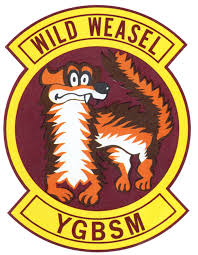Weasels and Innovation
Curator’s Note: The Wild Weasel went from Pentagon recommendation to SAM killer in 5 Months which is amazing for an aircraft major modification and the training and coordination of adding a crew member. This was not accomplished without an incredible teaming of engineers, developers, aircrews and acquisition personnel. These stories will tell the story of innovation. Enjoy!
When Majors could do Things!
Dave Brog
I remember a time, about 29 years ago, when there appeared in the skies of North Vietnam a Black SAM.
No one had ever seen or heard of the Black SAM, but everyone had a suspicion of what it was. They did not think that it was the SA-2. The prevailing suspicion was that it was an SA-4. Many did not think that it was the SA-4, but that “many” could not prove that it was not. That “many” included a group of politically incorrect USAF majors who worked in the Pentagon. These majors were non-PC, because they were all above the rank any of them ever expected to be and were very mission oriented. They were Bob Klimek and Lou Chesley from the R&D side, Jim Thompson and Leon Hoffman from the LG side and Jack Donovan and myself from Ops.
We all recognized the limitations of the AN/APR-36/37 RWRs, which were hardwired and could not be changed with the threat. We had already seen the SA-3s used in the Middle East and the growth of SAM threats in the Warsaw Pact. We had no RWR in USAFE, or anywhere, that could see the newer threats. We did, however, have a system in R&D, nicknamed Mongoose, which was a digital RWR processor built by a west-coast company called Dalmo Victor (DV). Unfortunately, we were moving very slowly in development and testing.
“Aha,” said the Majors. This new Black SAM might be bullshit, but it could be the horse to ride to get the digital reprogrammable RWR that we knew we needed for the future. So we caucused in the basement of the Pentagon, near the Purple Water Fountain, and agreed that we would push to the limit to get the digital RWR into the inventory.
The first step was to get with the Warner Robins Air Logistic Center and its Ace EW software engineer, Joe Black, to find out what it would take to get DV to speed up its effort. He told us the amount of money and time that we would need and what had to be done. This was March 1972, and if everything went right we could have the first operational install into the F-105G in January 1973. The F-4Es would follow. We then had to find the money. So Klimek and Thompson started to root around for the dollars. The R&D dollars were easier to find. Jim Thompson had the hard job, finding Class-5 mod money for the installs. He finally found the dollars by robbing the usual sitting pots, T-38 windscreen mods and F-4 smokeless-engine mods, which almost always sat number one and two on the Class-5 mod list priorities but never got funded. It was a wonderful petty cash fund.
Once we got the funding lined up, we decided to find out what kind of priority we could get to move the program. Fortunately, we had a colonel named Howard Leaf (bless his good heart) heading up the special SEA/Mid-East emergency requirement effort. We went to him, and he said to go to a certain colonel and ask him to give you a “DX Brickbat” priority — the highest priority in DOD. We got it and drafted the message that we intended for General Jack Ryan, then CSAF, to sign out to get the this program going. Within a week we had 19 general officers across the Air Staff to coordinate. There were some staff officers who did not want to concur — not the generals, but the colonels and below. We would not, however, accept a simple non-concurrence. We said that if they did not agree with the message, they should write a letter of non-concurrence explaining their reasons, and we would take their letter with us to the next level of coordination. Interestingly enough, all the non-concurrers backed off. Ryan signed the message, and we were on our way.
The next step was to get some flight testing once we had the system ready. We knew that using the system in Europe would be a hit/miss proposition. We didn’t know if the Warsaw Pact would cooperate and turn on the threats when we flew by the border. We did know that the Israeli Air Force was seeing the SA-2C (the G-band version) and the SA-3 on a daily basis. I decided to ask the IAF if they would be willing to flight test the new digital RWR, now called the AN/ALR-46, against the threat along the Suez canal and in Egypt. Their response was “Yes, but.” I asked what is the “but?” They replied, “We want it, too.” I very shortly got the Air Staff and powers that be to agree that in return for flight testing, the IAF would be allowed to get the ALR-46 for their F-4Es.
In August 1972, we put a team together consisting of DV engineers and Warner Robins engineers, led by John Lavecchia. In three weeks they installed the ALR-46 and flew enough flights to determine that the ALR-46 worked as advertised. We started the procurement and had the first ALR-46 in an F-105G in SEA in January 1973.
And the rest, as they say, is history.
Dave Brog, a retired USAF colonel, flew F-105F Wild Weasels during the Vietnam War. He later served on the Air Staff and at USAFE, where he was responsible for tactical-fighter EW and Wild-Weasel operations. He is president and CEO of I.R.D., Inc., an international defense consulting firm in the Washington-DC area.
